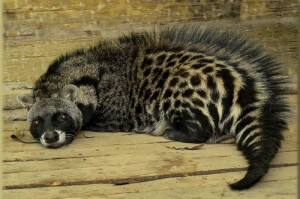According to a recent article in Scientific American, the best way to lure a jaguar to a camera trap is by spraying the surrounding tree branches with Calvin Klein’s “Obsession for Men” cologne.
The camera traps are used to take photos of the jaguars and collect research data. When a jaguar approaches the trap, infrared sensors trigger the camera.
“Obsession for Men” is described by the manufacturer as a “masculine blend of botanics, spices and rare woods.” One of the scent’s main ingredients is civetone, which is produced from the glands of civets.
The civet, a nocturnal cat-like mammal with raccoon facial features, lives in the tropical forests of Asia and Africa. There are over a dozen different civet species. The civet Viverra civettina is listed as Critically Endangered on the IUCN Red List of Threatened Species.

The animal’s gland secretions have been used to make perfume for hundreds of years. However, the number of perfumes containing civetone has been on the decline since the development of synthetic musk. Channel No. 5 stopped using civet in their perfumes in 1998.
The procedure for removing the secretion, which is extracted every two to three weeks from a sac under the civet’s tail, is extremely painful.
In 2004, the Chinese government killed over 10,000 civet cats in captivity when a man became ill from a new strain of the SARS virus that was similar to the SARS virus found in civets.
In addition to the use of glandular sections to manufacture perfume, civets are also killed for their meat, which is considered a delicacy in Asia.
A coffee made in Vietnam and the Philippines is produced from coffee cherries that have been partially digested by civets. A 2012 investigation found civets being force-fed the cherries and living in horrific conditions.
Are you or someone you know using perfume or cologne with civetone? You may want to start shopping for another product. Check the bottle’s ingredients to find out.


0 Comments